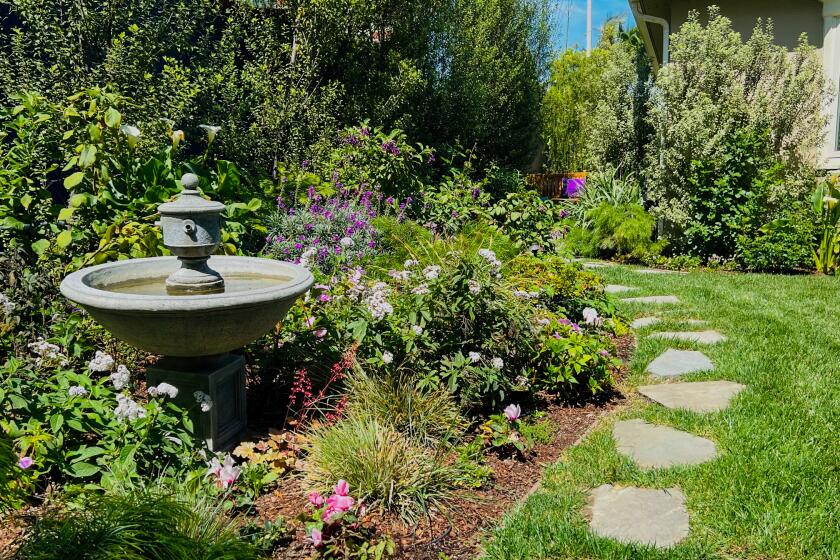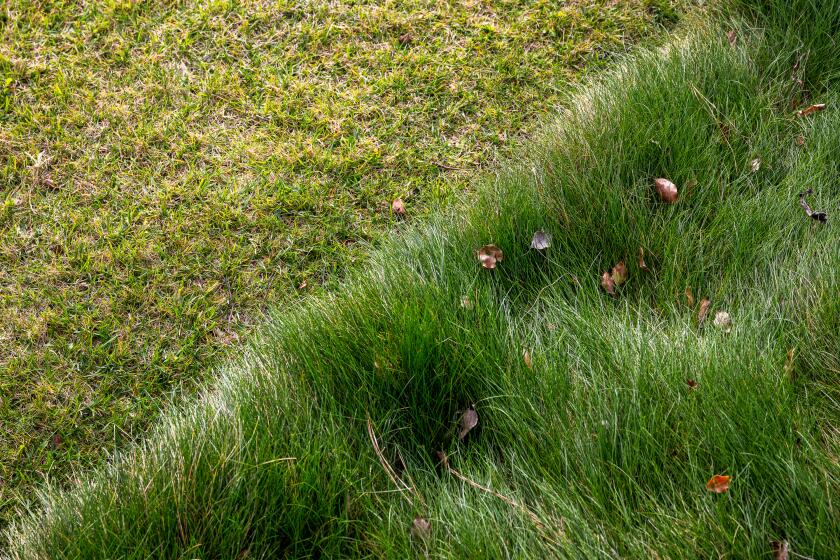
- Share via
Water-hungry lawns are symbols of Los Angeles’ past. In this series, we spotlight yards with alternative, low-water landscaping built for the future.
Once upon a time, under Universal Studios’ watchful Minion eye, there was a Storybook house in Studio City with a steep, sagging roof, a towering, tottering chimney and a yard so boring and prone to flooding that its charm was pretty much negated.
The front yard was mostly dead grass; the driveway was cracked and broken from runoff whenever it rained; and the funnel-shaped backyard was overwhelmed by a rotting wood pergola.

Succulents in the front yard grow in an alcove built into the chimney.

A planter spills over with succulents in Michael Solberg and Khoi Pham’s home garden.
No longer. Today, the yard of Khoi Pham and his fiancé, Michael Solberg, is a wonderland of native plants, water-conserving bioswales, a patio mosaic made from recycled concrete and permeable gravel paths with a delightful crunch. And throughout the garden are little riots of succulents spilling from pots, baskets and even the fanciful nook built into their chimney, dotting the garden with jolts of color like fancy embellishments on a cake.
L.A. Times Plants, the Theodore Payne Foundation and the California Native Plant Society team up to offer an immersive introduction to native plants at Festival of Books.
There are lots of little signs identifying the plants too, to feed Solberg’s vision of educating passersby about the beauty, practicality and sustainability of native plant landscapes. The signs “make you feel like you should stop and pay attention,” said Solberg.
But they’re also helpful because this yard, designed and built by landscape designer Isara Ongwiseth of FormLA Landscaping, is one of three featured gardens during the Garden Conservancy’s San Fernando Valley Open Days Garden Tour on April 28, and the only one featuring a landscape devoted to California native plants. (Tickets are $10 per garden.)
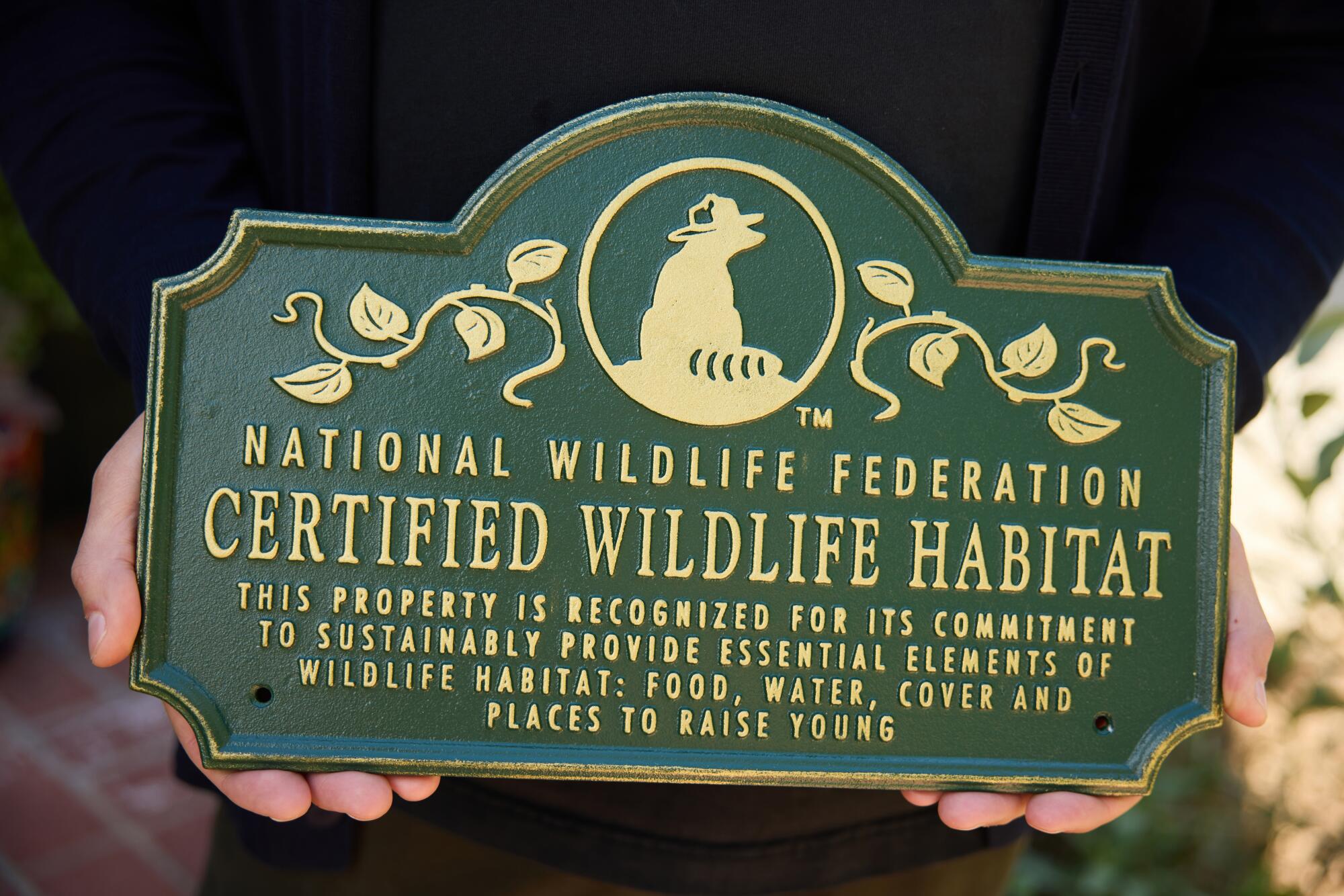
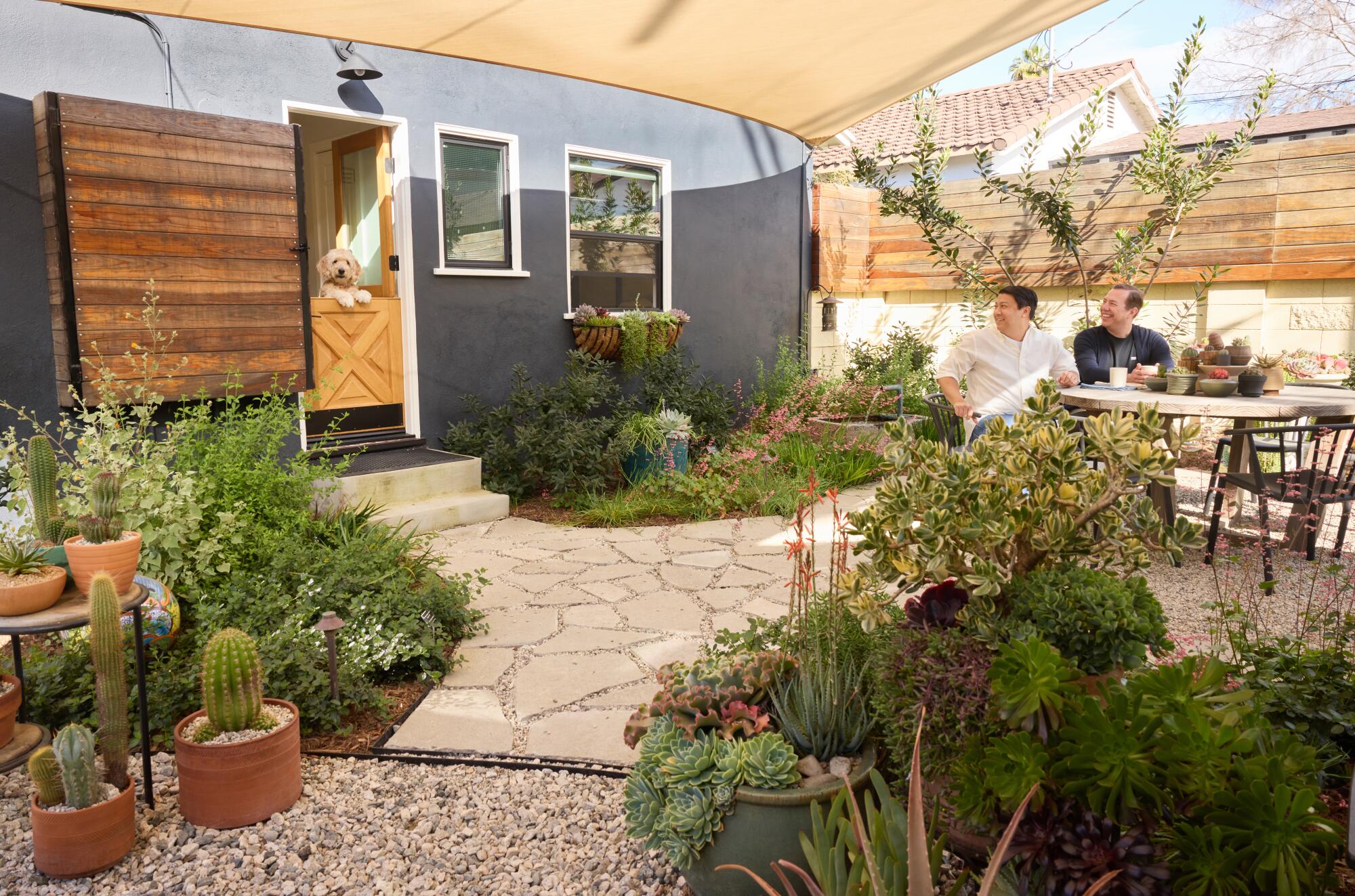
The landscape is lush for one so young — it was installed in February 2022 — and features multiple plantings of a few varieties of native plants, such as the red-berried toyon, which Solberg is trying to espalier along one wall of his garage, dark-green ceanothus shrubs mingling with the silvery leaves of white sage (Salvia apiana), rings of Douglas iris (Iris douglasiana), earth-bound wisps of blushing coral bells, a.k.a. Wendy alumroot (Heuchera ‘Wendy’) and two Western redbud trees (Cercis occidentalis) — one in front, one in back — that bloom in deep violet clouds each spring.
For the record:
9:24 a.m. April 15, 2024An earlier version of this article incorrectly stated that the landscape was installed in February 2021. It was installed in February 2022. A photo caption incorrectly said the house is in North Hollywood. It is located in Studio City.
Out front are islands of fragrance that bloom in varying shades of purple — coyote mint (Monardella villosa), Cleveland sage (Salvia clevelandii) and bee’s bliss sage (Salvia ‘Bee’s Bliss’), along with clumps of deer grass (Muhlenbergia rigens), Oregon grape (Mahonia aquifolium) and the deep-throated flowers of Margarita BOP penstemon (Penstemon heterophyllus ‘Margarita BOP’).
Basically, Solberg said, except for the creeping fig lacing the chimney and the giant camphor tree on the parkway in front, any plants in the ground of their new landscape are California native plants; others, like his succulents and dwarf lemon, are planted in pots. And he hopes their plantings encourage more of the same.
I wanted to get the word out that native plants are a great way to have a sustainable garden that doesn’t require too much water, is good for wildlife and insects, is easy to care for and looks great too.
— Michael Solberg
“You just don’t see a bunch of California native gardens in our neighborhoods. What you see is lawn and standard shrubs, or fake turf or people who just paved everything over,” Solberg said. “I wanted something unique and different for our landscape, but also responsible with water and nature, and education was a really big part of that. I wanted to get the word out that native plants are a great way to have a sustainable garden that doesn’t require too much water, is good for wildlife and insects, is easy to care for and looks great too.”
This was Solberg and Pham’s second foray into creating a native plant landscape. Before they bought their Storybook home in late 2019, they’d taken out the lawn in front of their former home in Sherman Oaks and, inspired by gardens they’d seen on the Theodore Payne Foundation’s Native Plant Garden Tours, decided on a water-conscious landscape that relied on native plants instead of cactus and drought-tolerant plants from other countries with Mediterranean climates.
The recent rains have made 2024 a fabulous year for flowers — just in time for spring garden tours around Southern California. Here’s a list of intriguing tours.
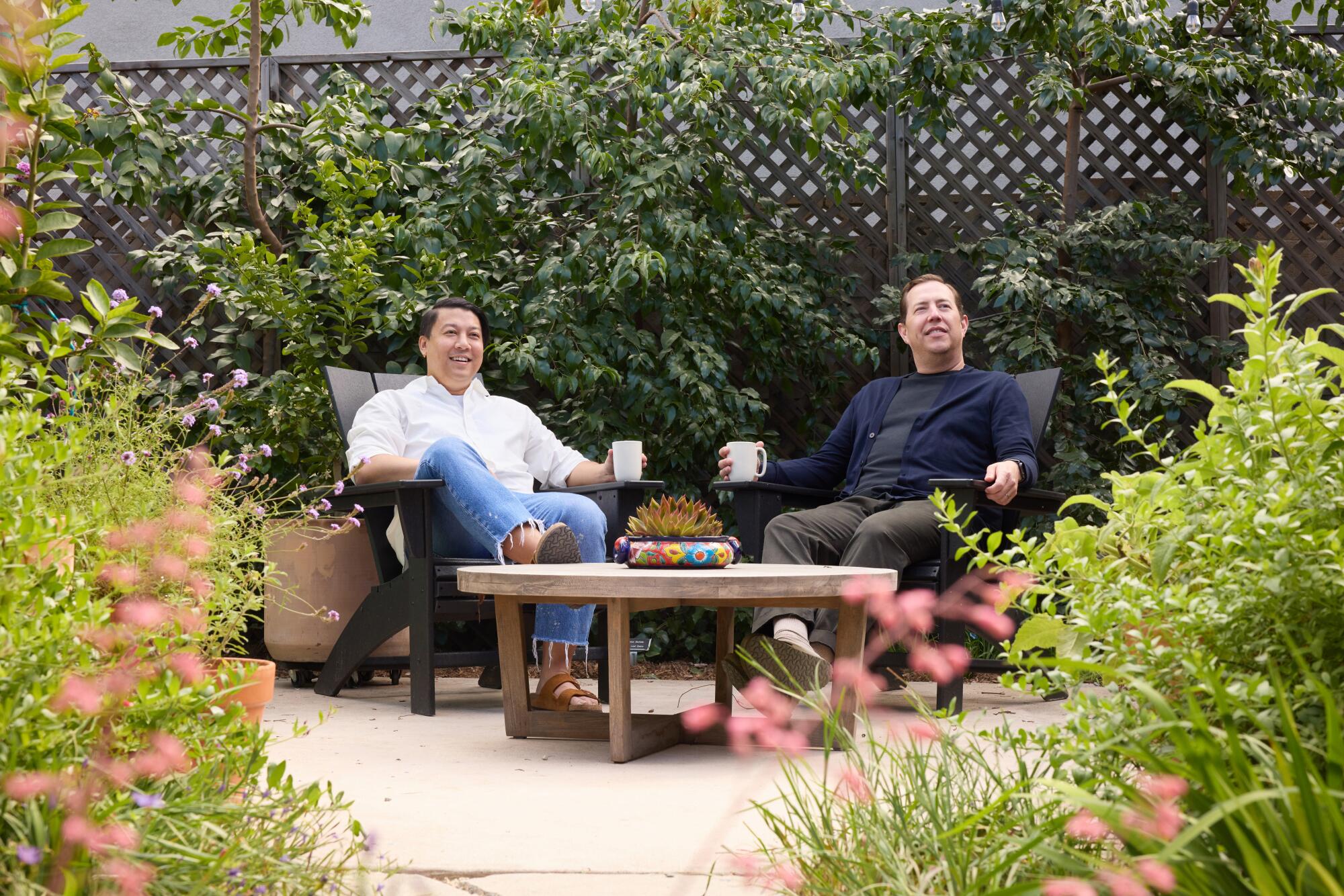
Solberg — the gardener of the family — said he learned a lot in that DIY project: what native plants grow quickly and slowly, which he liked the best and which ones he should have placed somewhere else (such as a Matilija poppy that rapidly outgrew its location).
When it came time to finally landscape their new home in Studio City, Solberg said he wanted to continue the same theme, but he was concerned about dealing with the property’s special problems — a small, weirdly shaped backyard dominated by an aging pergola and water that ran off their Hansel-and-Gretel roof in sheets, creating runoff and flooding.
So in addition to an all-native-plant landscape, Solberg wanted permeable surfaces that would trap water in the soil instead of sending it out into the street — but he didn’t want any gutters to ruin their roof’s unusual lines. He wanted gravel walkways and drives that wouldn’t require constant maintenance. He wanted year-round color and interest, shade and privacy from the tall apartment building behind their house and plants that would attract birds and other pollinators.
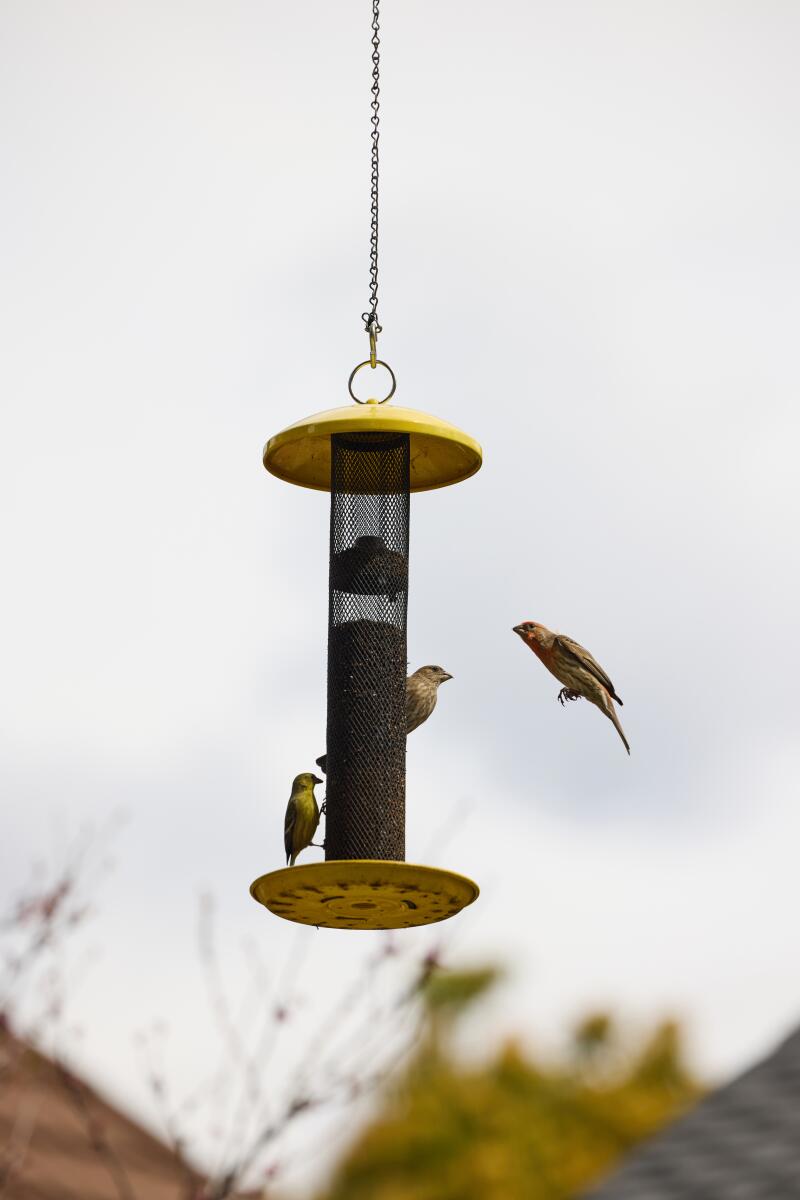
Birds fly around a feeder in Michael Solberg and Khoi Pham’s front yard.

A bee noses among the pink blooms of a spray of coral bells.
They also had lifestyle considerations: Both men work from home — Solberg full-time overseeing corporate retail operations for a chain of tool stores and Pham at least two days a week as a research and development scientist for medical devices such as hospital sterilization equipment — so creating a serene and cheerful work environment was crucial inside and out.
And then there were Pham’s concerns. He was happy to leave the plant decisions to Solberg, the green thumb of the family. “I do the budget, but when it comes to gardening, I’m more of a cheerleader,” Pham said. “I was thinking more about the parties I’m going to throw in the backyard, and how they have to flow a certain way.”
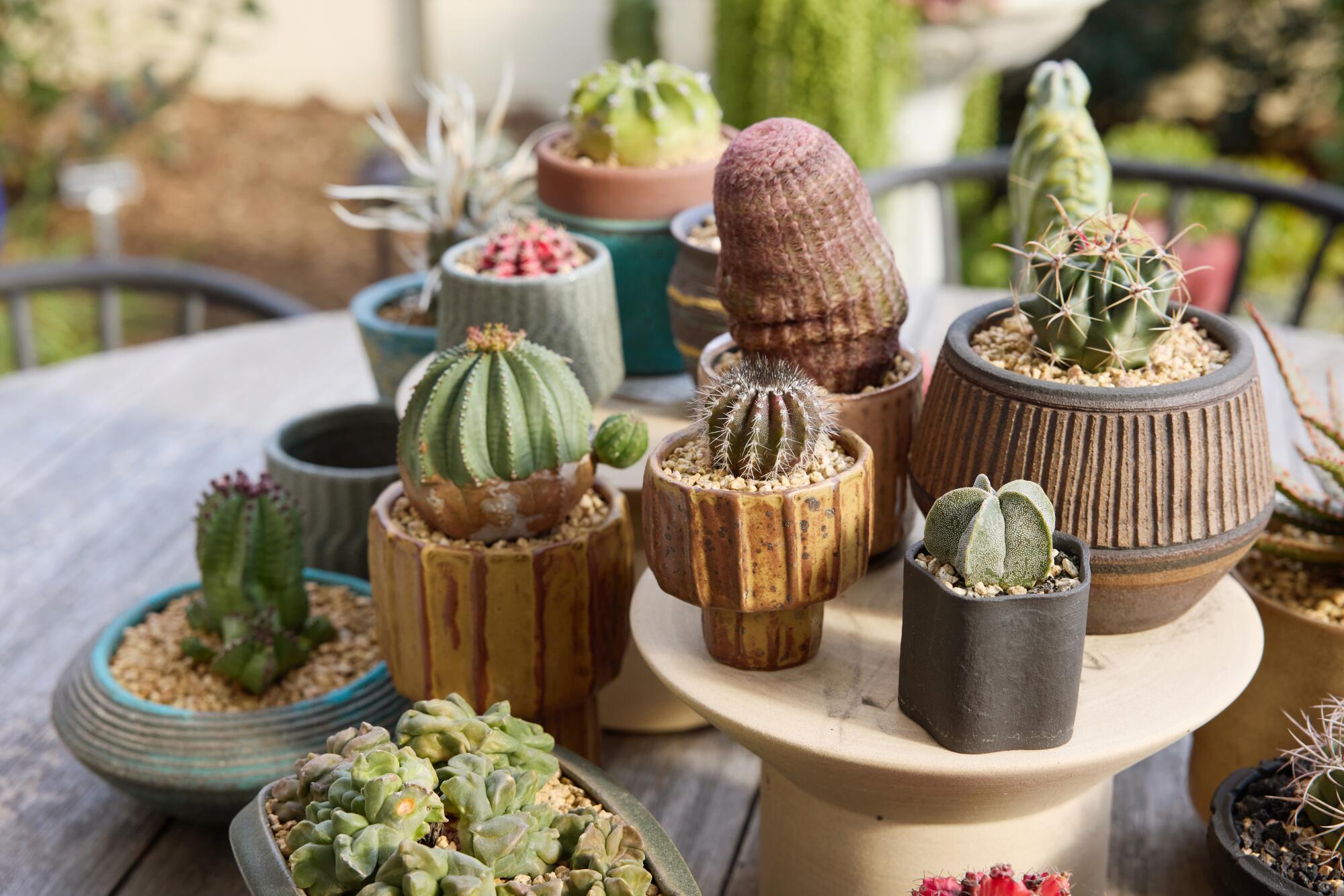
Solberg grew up around plants and gardening, but Pham said they were never a part of his life until the two met in San Diego in 2011. “When we first met, he had a beautiful succulent garden on his tiny patio that was really impressive — I had plastic succulents I bought from Crate & Barrel,” Pham said, laughing. “I just dusted them every once in a while.”
So there were lots of things to consider in creating their new landscape, Solberg said, plus he already knew how much work it was to take out a lawn and create a new landscape. So in the end, they called FormLA Landscaping, because they had admired the firm’s native landscapes in the past, and began laying out their wish list to Ongwiseth, the lead designer.
It took a few tweaks and persuasion — and $60,000 — but in the end, Solberg and Pham said Ongwiseth made their vision better than they had dreamed.
But there were a few bumps along the way.
It’s taken a decade, but Raul Rojas and Thomas Zamora have turned a Highland Park yard of hard dirt and junked cars into a lush expanse of native plants, succulents and vegetables.
One of the first decisions was removing the raised wooden deck in the backyard, Ongwiseth said. Pham and Solberg were reluctant not to rebuild, until they saw how much space the removal created. “It put everything at ground level, so you feel like you’re part of the garden instead of above it,” Solberg said.
Solberg was adamant about not wanting gutters to clutter up the roof line. Ongwiseth used French drains around the house perimeter — basically a trench filled with gravel and a perforated pipe to capture the runoff and direct it to the bioswales in the front yard. Ongwiseth finally convinced Solberg to add a small section of gutters on the south side of the house, along the driveway, where they were nearly invisible.
The two bioswales in the front are like planted indentations in the ground that fill with water after a heavy rain and hold it long enough that it sinks in. The gutters help direct rainfall into pipes that drain into the swales. Once they removed the broken concrete driveway and replaced it with ¾-inch crushed angular gravel, they found the rocks helped trap water coming off the roof as well, so that it sunk into the ground instead of pooling and flooding in spots like the old driveway. They also installed a subterranean drip irrigation system, which automatically waters two days a week for 10 minutes. The system uses sensors to skip watering days if it’s raining.
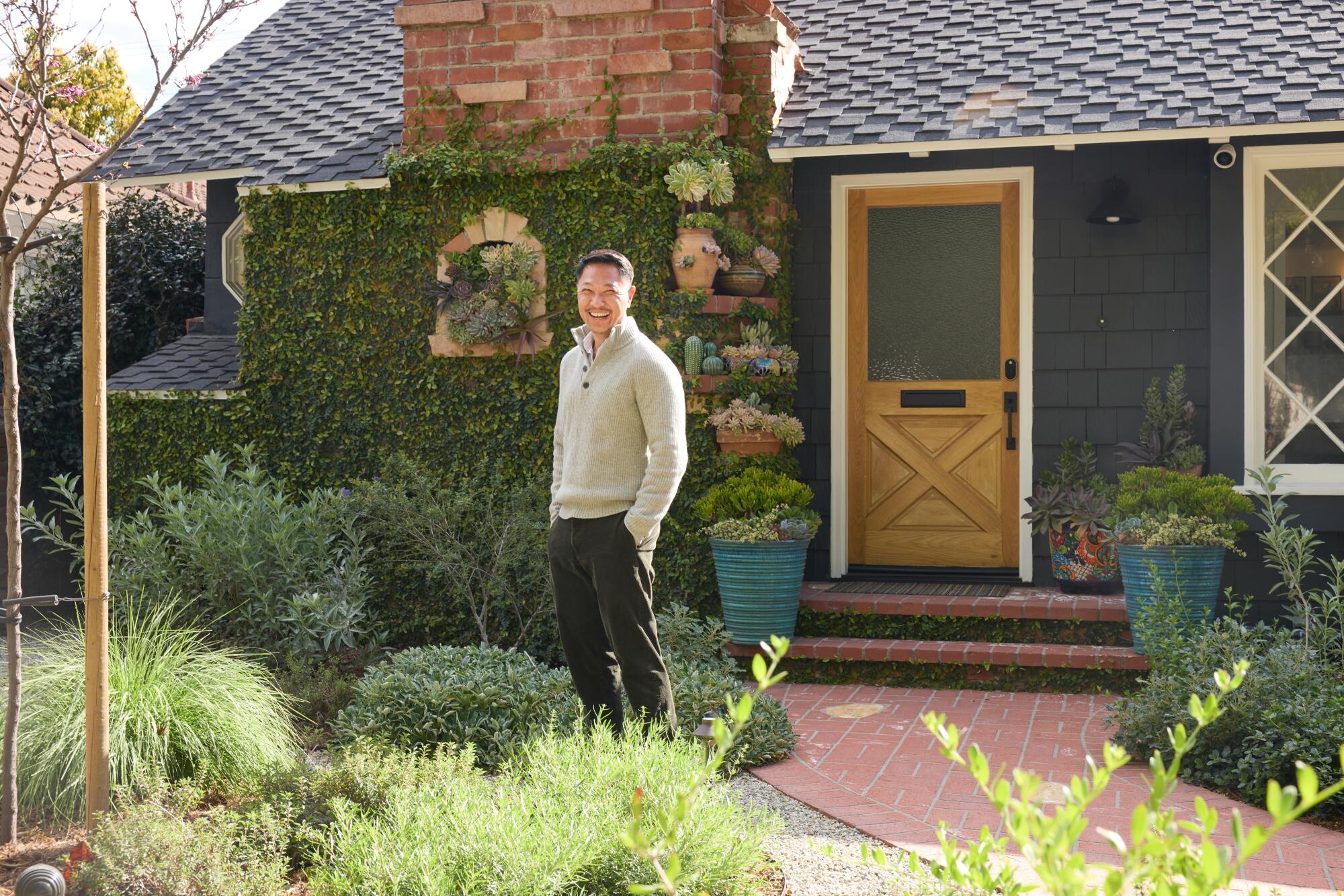
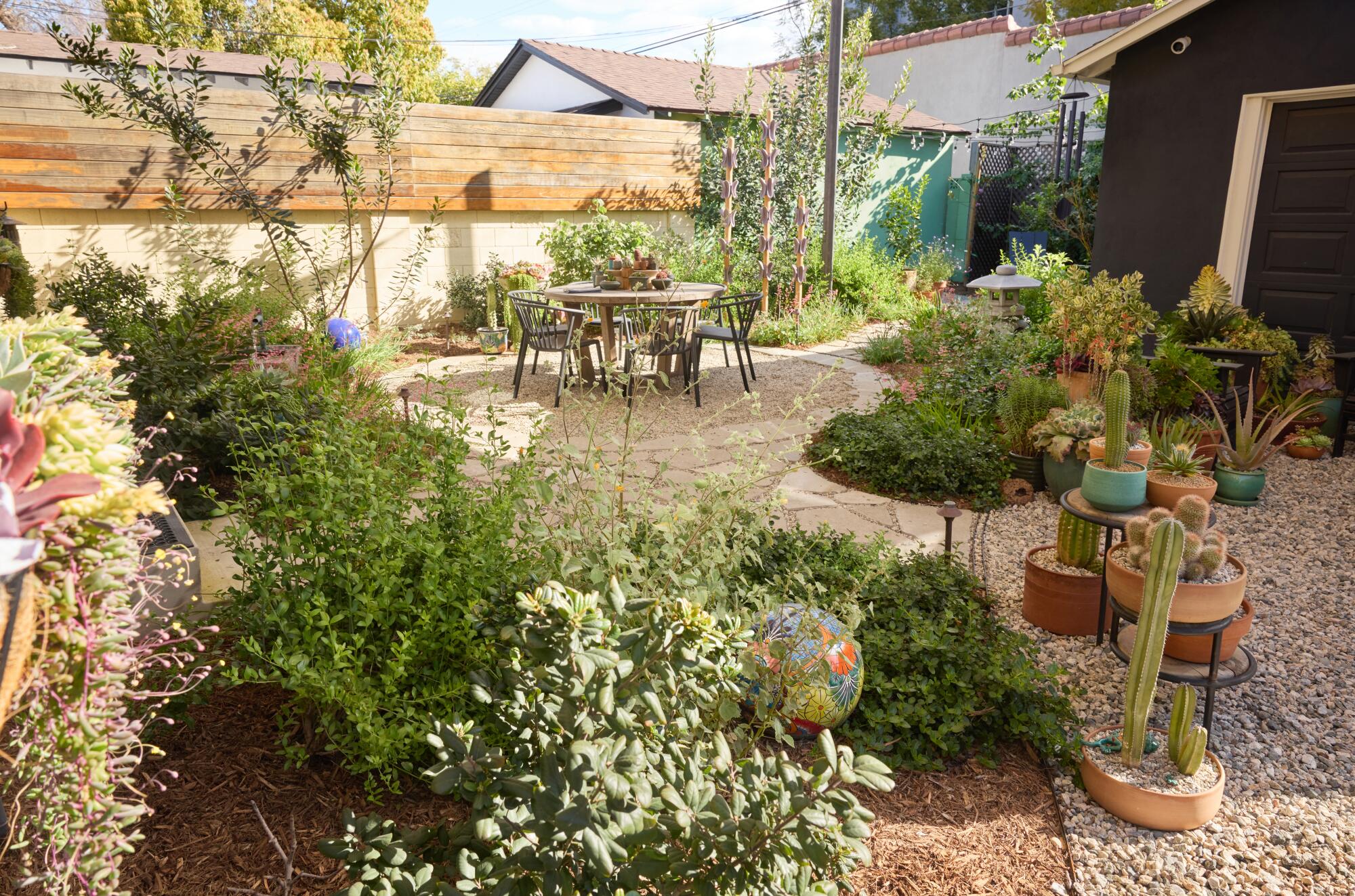
The swales are edged with meandering paths of smaller, 3/8-inch angular gravel, and mostly hidden by the plants. Gravel was high on Solberg’s wish list, partly for sentimental reasons. His grandmother had gravel paths, he said, and he always loved the way they crunched when he walked on them. There’s a security aspect too, Ongwiseth said: “You’ll always know if somebody has wandered into your garden.”
But creating permeable paths and drives is more challenging than you’d think, Ongwiseth said. “Gravel and decomposed granite sounds good, but then you start tracking granite into the house and scratch the floor, so what do you do with that?” And round smooth gravel may look nice from afar, but your feet sink into those rocks when you walk on them, and they tend to scatter everywhere when children or dogs scramble by. (Pham and Solberg have two rambunctious dogs — Lucy, a goldendoodle, and Teddy, a terrier mix.) Because the kind of gravel Ongwiseth chose locks together, the small rocks stay in place when you walk on them, and your feet feel supported instead of sinking.
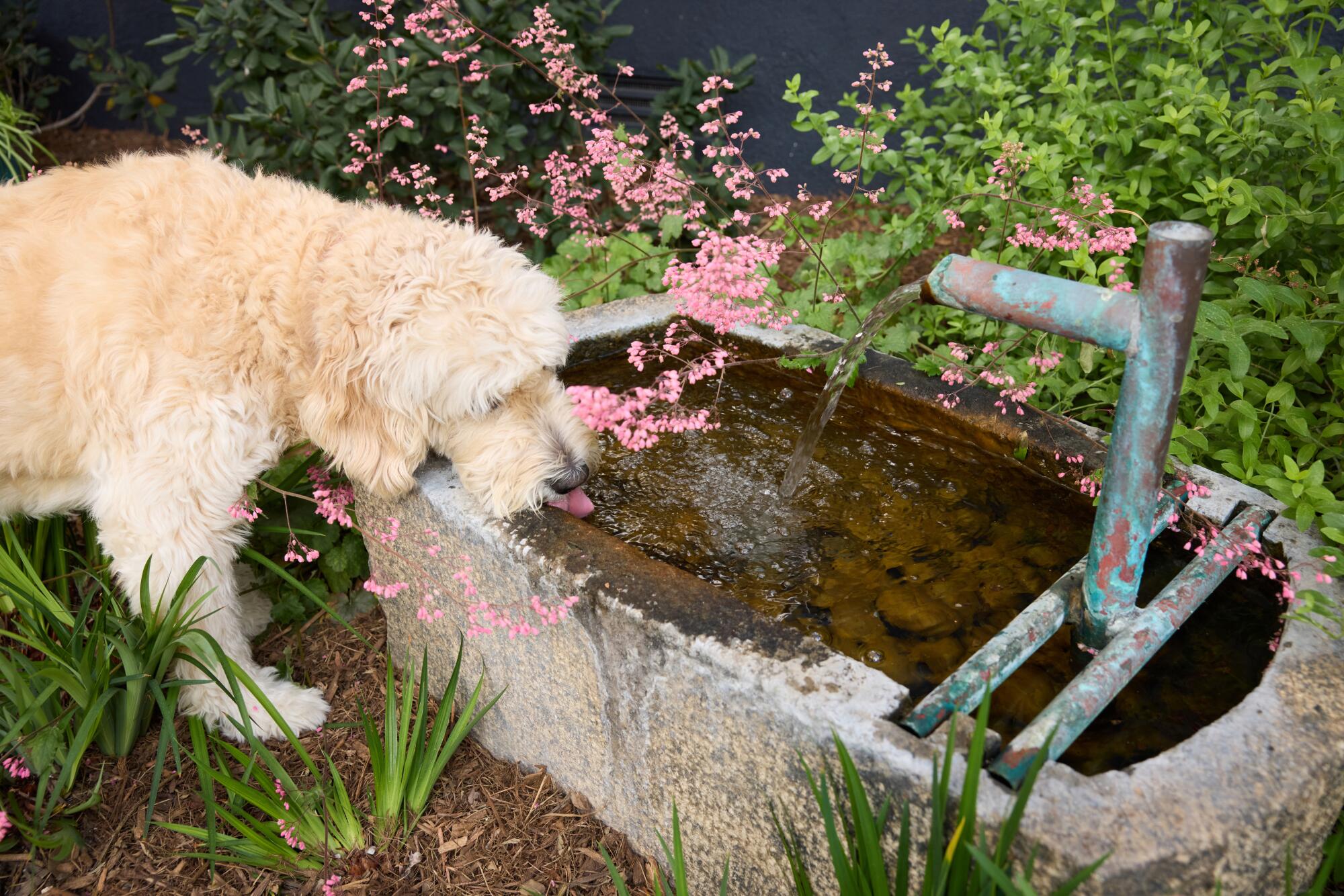
Preparation was important too. After they tore out the old driveway and created the paths, they removed any weeds, added another drain at the end of the driveway and laid down a geo-textile fabric that suppresses weed growth while allowing water to soak through, before topping off the areas with two inches of gravel.
“Choosing the right type of weed barrier is very important, because so many will start to degrade over time,” Ongwiseth said. “The geo-textile fabrics don’t do that. I have many gardens I’ve installed in the last 15 years where the weed barrier is still holding up.”
Another point of concern was Ongwiseth’s plan to frame the gravel seating area outside the back door with a mosaic of broken concrete. “Broken concrete doesn’t sound very nice,” Pham said, “It felt a little too DIY, but once it was installed, I was like, ‘Oh, where else can we install it?’”
In fact, Pham said, you can still see a portion of rebar in one of his favorite pieces of concrete, “because it shows that it was reused. It truly is an art; they had to chip away at pieces of concrete to put the puzzle together to make it fit into the space.”
Tearing out your lawn but still want a swath of green? Try planting water-saving (and labor-reducing!) California native grasses instead.
The finished design does look artistic, but it was all part of Ongwiseth’s practical considerations about transitioning between yard and home. He wanted a design that basically cleans your shoes of any dust or debris before you step inside. He grew up in a traditional Asian family where everyone takes off their shoes before they enter a home, “but not everyone practices that, so creating a landing or space even with concrete provides that transition.”
He also wanted to honor Solberg’s vision of having permeable surfaces throughout the garden, so instead of big concrete slabs there are spaces between all the small pieces of concrete to allow water to sink into the ground. Those spaces can create uneven places for chairs and tables, he said, so he made the main seating areas all gravel rimmed by the decorative pieces of concrete.
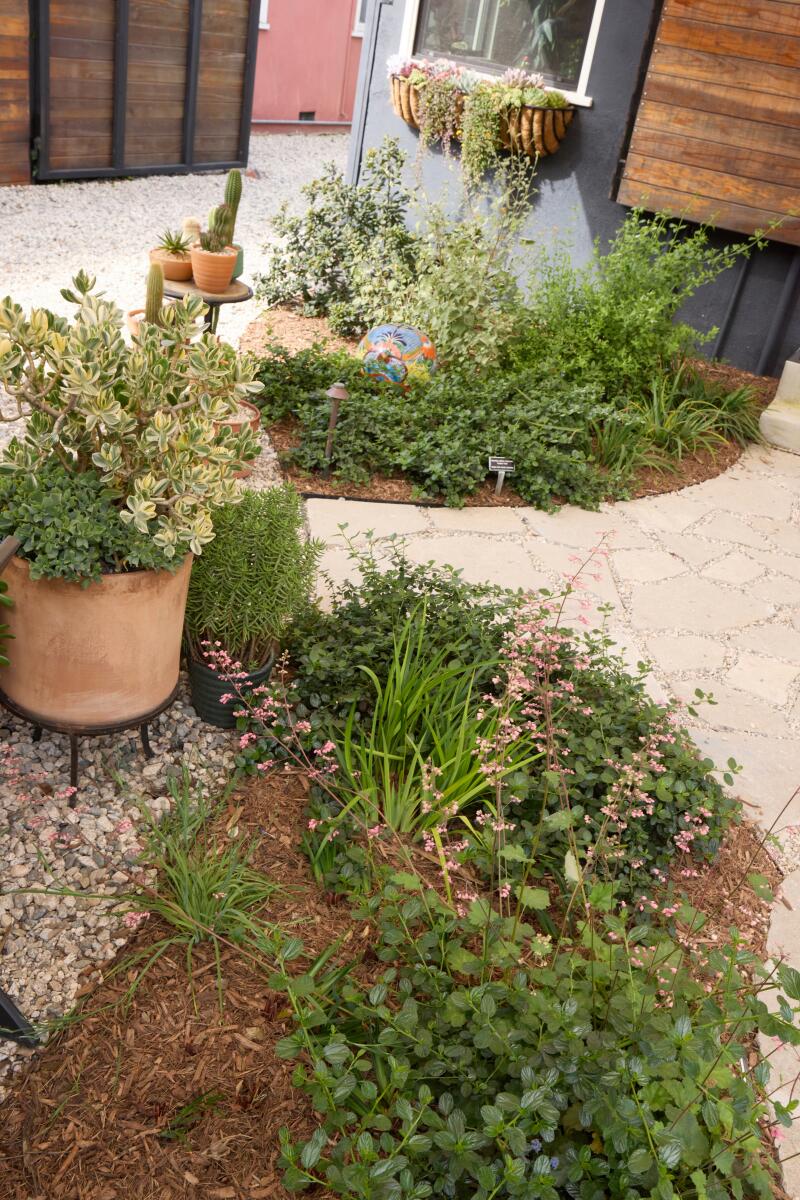
Broken concrete and gravel creates a walkway between planting areas and pots of succulents.

Michael Solberg’s pots of succulents add jolts of color around the home’s native plant landscape.
Ongwiseth also considered the fantastic Storybook design of the house in creating his design. As visitors will see, there is a sense of mystery and exploration as you walk from the front to the back.
“I wanted to create a meandering garden experience, where the whole garden is not revealed right away,” he said. “When we first arrived, we noticed the awkwardness of the shape of the backyard, and that old shade structure [the pergola] just emphasized that awkwardness. Once we removed all that we came up with a design that was more fluid, something that makes you want to explore the richness of the foliage, and the sense of many destinations throughout.”
There was a final and unexpected challenge, when Pham and Solberg were forced to remove a large camphor tree that provided privacy and filtered shade in their backyard. The tree had grown into their neighbor’s garage so it had to be removed, exposing their yard to the multistory apartment building behind them.
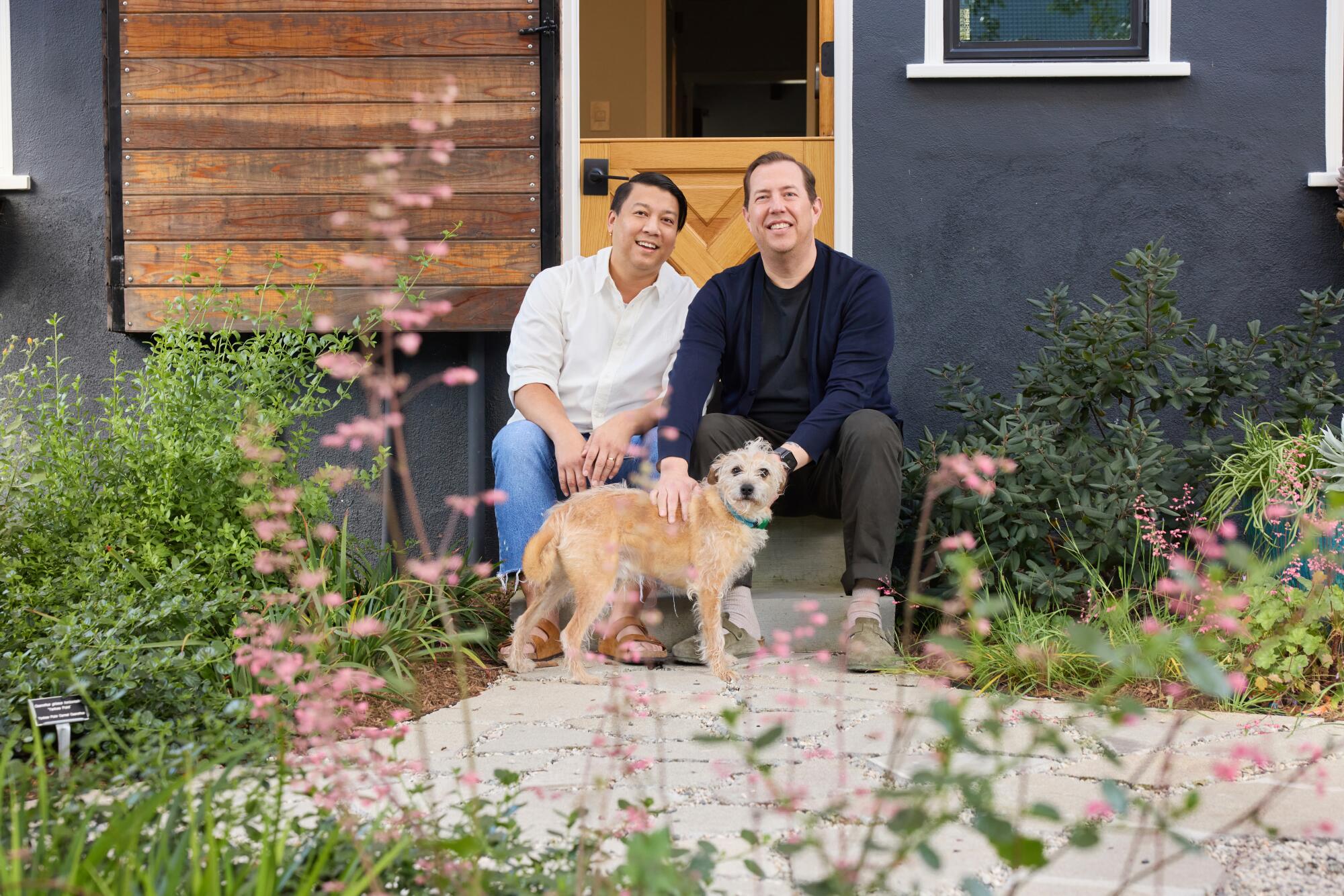
Ongwiseth softened the privacy issue by installing a large sail-shaped cover stretching from the house to the detached garage, which provides welcome shade during the summer but allows enough sunlight to filter through to keep the plants happy. They planted another redbud tree in the space where the camphor once stood — freeing up some additional space for their barbecue as well — and a bank of hollyleaf cherry (Prunus ilicifolia) at the very back that are already tall enough to block out a large swath of the apartments.
All in all, Pham and Solberg are still pinching themselves about how well it all came together. “There’s a healthy water table under our house now,” Solberg said, laughing. “And maintenance-wise, there’s not a lot we have to do. I have a blower to get rid of excess leaves once in a while, and sometimes, when it gets a little overgrown, I have to get out my clippers, but for the most part it tends to itself.”
Native plants don’t just provide color and habitat in our yards, they also create beautiful, long-lasting, fragrant bouquets with the right preparation.
These days, they can work outside at a large round table, with its small pots of colorful succulents, or drink coffee in the seating area nearby. Those places are separated by only a few steps, but they feel like a journey, admiring the tall abstract Dustin Gimbel sculptures of salvia whirls, next to real salvias blooming nearby, or the pots of blooming De La Mina verbena (Verbena lilacina ‘De La Mina’) and fragrant pitcher sage (Lepechinia fragrans).
This lovely space is where they’ll host their wedding reception in July, for about 50 people, the wide driveway functioning as a seating area as well as a way to drive in and out of their garage. Pham has his party flow, and Solberg has his vision of a landscape both beautiful and sustainable, visited by pollinators and birds.
“My advice is, just trust the process,” Solberg said. “Normally I would want more control, but I gave up creative license and learned a lot, like the Palmer’s Indian mallow (Abutilon palmeri) — I never would have chosen that for our garden because I didn’t know about it. So I learned, if you trust in the process, you can end up with something incredible, better than if you had done it on your own.”
More to Read
Sign up for The Wild
We’ll help you find the best places to hike, bike and run, as well as the perfect silent spots for meditation and yoga.
You may occasionally receive promotional content from the Los Angeles Times.

